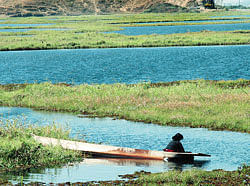Jewel of the east

As we arrived in Imphal, we got the first whiff of the simmering unrest, the 12-hour curfew and the sense of fear and disillusionment of the people. The sight of gun-toting security forces trotting around, keeping vigil over militants, was intimidating. We discovered that this was a stark contrast to the land described by Nehru as the ‘Jewel of the East’, where Gods danced and kings played polo. With the time restrictions and an undercurrent of tension around, sightseeing posed a daunting challenge for tourists like us. We decided to make the optimum use of the time to cover as many places as possible in the limited time before the curfew deadline.
Historical ruins
Starting our Imphal sojourn with the getaways on the outskirts of the city, we zipped through the historic highway and stopped by some famous memorials and cemeteries of the British and the Indian army. The eerie silence of the war cemeteries was a gory reminder of the gruesome bloodbath between the British and Japanese forces and the misery and devastation humanity suffered during the second World War. Well maintained by the Commonwealth Grave Commissions, its stone markers and stone plaques stand testimony to the sacrifice made by the soldiers.
Moving away from the war memorials, we reached Moirang (45 km away from Imphal), which was the headquarters of the Indian National Army for a short spell during World War II. It got international prominence on April 12, 1944, when Netaji Subhash Chandra Bose’s Indian National Army (INA) hoisted the Indian flag for the first time on Indian soil. We too a peek at the collection of letters, photographs, articles, records and other memorabilia on display at the INA Museum.
The highlight of our trip was a visit to the dream-like Loktak Lake. This unique habitat shelters scores of bird species as well as a community of fishermen. We watched the lake stretching around us and soaked in the life — islands of floating weed that drift around the lake, shimmering blue waters, serpentine waterways, fascinating water plants, families who live on (literally and figuratively) the lake in small floating huts set up on floating islands of weeds and humus known as phumdi.
From the high perch of a vantage point, we had a bird’s eye view of the lake and fishermen plying their tiny skiffs, casting their nets on the lake, and rearing fish farms in it using nets as floating walls. The southern reaches of the lake form the Keibul Lamjao National Park, the last refuge of the endangered Manipuri deer. On the reedy marshes and swamps fringing the lake live the brow antlered deer.
When we reached Imphal town, we could sense the discontent among the locals as they moved around doing their daily chores. Leaving the cab, I wished I could take time off to walk through Imphal town. But hiring a cycle rickshaw to all the important places was a better option. The first halt in my itinerary was the more than 2,000-year-old Kangla Fort, the erstwhile palace and fortress of Manipur, later occupied by the British. No other monument holds as much cultural and archeological significance to the people of Manipur. The area of Kangal Fort is dotted with many monuments of significance. There are citadels and ruins of old palaces inside, a cremation site, a huge moat and the sculptures of the dragons of Kangla Sha, all restored by the State’s archaeology department.
In the heart of the town are two memorials — the towering Shaheed Minar in Tikendrajit Park that commemorates the martyrs who died fighting British colonialism, and the War Cemetery that revives the memories of British and Indian soldiers, who had laid down their lives during the second World War. Another intriguing attraction is the State Museum located near the polo ground. It is a store-house of Manipur’s rich history. On display are works of art, textiles, besides a portrait collection of former rulers of Manipur and armoury of the royal army. Though Manipur is the birthplace of polo, we were not fortunate enough to witness handsome polo players, in all their cultural finery, on horsebacks.
Local handicrafts
But we were lucky to be in Manipur during Holi, when thousands of devotees throng the premises of the Govindajee Temple to offer their prayers and perform ceremonial dances. It was a treat to see men in white dhotis and chadors play the Manipuri drums, while boys and girls sang and danced together to the beat of drums.
The Khwairamband Bazar or Ima Bazar, located at the epicentre of the town, was the last halt in my itinerary. It is regarded as the biggest bazar in Asia, dominated by women entrepreneurs and traders. The women in their stunning sarong-like wrap-arounds and shawls added colour to an already colourful Manipuri bazar. From perishable vegetables to everlasting intricately woven handlooms and handicrafts, the market has something for everyone.
A motley lot of women were selling tribal ornaments, a mishmash of modern and traditional jewellery, while a few others were busy checking out traditional woven shawls, bed sheets, table coverings, dress materials, cane baskets, bamboo furniture, dolls, household tools, et al. I wished I could tarry a little longer at this unique market. But, I had to rush to my hotel before the curfew hour.